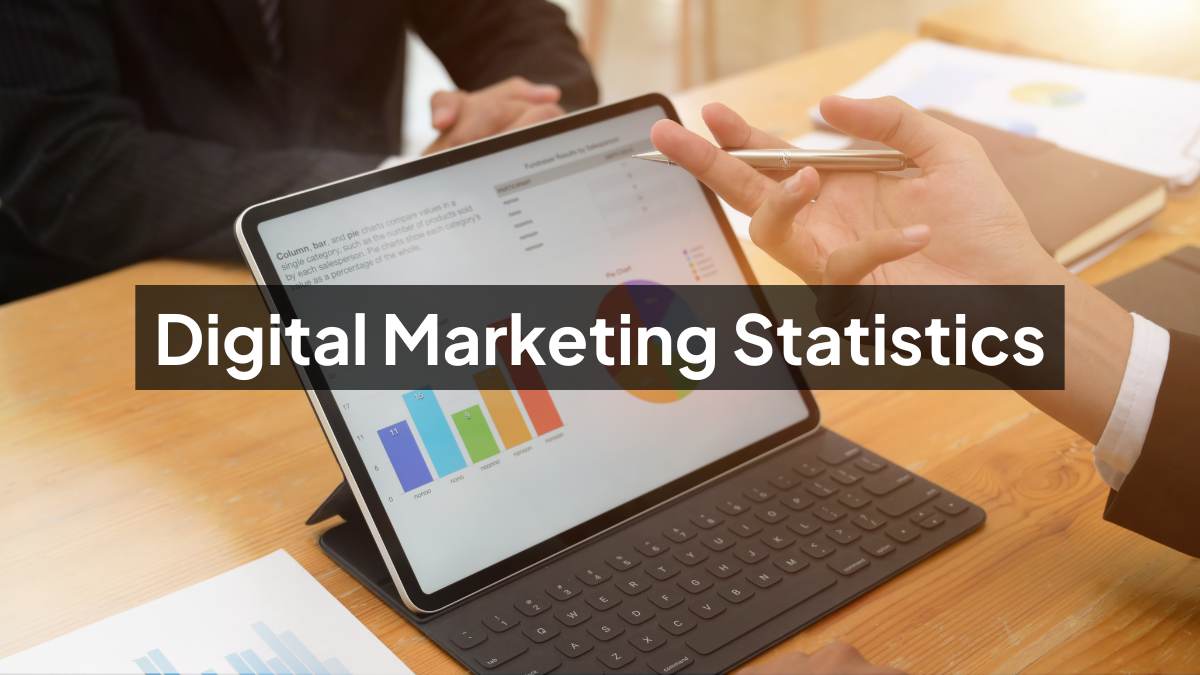Table of Contents
Introduction
Digital marketing in 2025 looks nothing like it did just a few years ago. The shift has been fast, budgets are bigger, platforms are evolving constantly, and technology is shaping how people interact with brands online. What stands out is that these changes aren’t slowing down.
Keeping track of the latest digital marketing statistics isn’t just about curiosity. It’s about knowing where to spend, what to test, and how to actually see better returns. Numbers give a clear picture of where attention is going and where businesses should focus energy.
The right data helps with:
- Deciding which channels deserve more budget
- Understanding which platforms actually drive growth
- Building strategies that deliver stronger ROI
Global Digital Marketing Spend & Growth in 2025
Spending on digital ads continues to rise, and the scale in 2025 is staggering.
- According to Statista’s latest Market Forecast, global advertising spending across all channels is projected to reach approximately $1.17 trillion in 2025, with digital ad spend accounting for roughly 73% of this total.
- Digital channels now take up 72.7% of all ad investments, showing how far traditional media has slipped.
- Mobile advertising dominates, with nearly two-thirds of the spend flowing into smartphones.
- Programmatic advertising makes up 82% of digital budgets, crossing $650B in 2024
This isn’t just about more money being spent online, it’s about how centralized and automated the ad world has become. For marketers, digital is no longer a part of the mix. It is the mix.
Also Read: Google Ads Statistics
Social Media Marketing Statistics for 2025
Social platforms are still the heartbeat of online marketing, and the latest numbers show just how central they’ve become.
- 5.24 billion people use social media in 2025, about 64% of the global population.
- The average person spends 2 hours 24 minutes a day scrolling, sharing, or watching. (Source)
- 91% of businesses are active on social media, putting around 15% of their marketing budgets into it. (Source)
- Platform highlights:
- Facebook: over 3 billion monthly users
- TikTok: more than 1.5 billion monthly users
- LinkedIn: 1.1 billion members, and 40% of B2B marketers say it’s their best source for leads (Source)
- Facebook: over 3 billion monthly users
Social isn’t just where people connect, it’s where buying decisions, brand discovery, and customer trust are being built every single day.
Also Read: 15 Most Important SEO Statistics
Content & Video Marketing Statistics 2025
Content is still at the center of digital marketing, and 2025 hasn’t changed that. If anything, the numbers show it’s only getting stronger.
- Around 74% of marketers say content helps them create demand or generate leads. (Source)
- Nearly half (49%) even link content directly to sales, which kills the old myth that content is just for awareness. (Source)
- The global content marketing industry is on track to hit $107.5B by 2026, that’s a serious number. (Source)
- Short videos and images are winning the battle for attention. About 29% of marketers say each of these formats works best for them in 2025. (Source)
- Video, in particular, is doing triple duty: pulling engagement, boosting SEO, and nudging conversions higher.
What’s interesting here is how short-form has taken over. People don’t always want long blogs or 10-minute explainers anymore. They want quick, snackable content that still delivers value. Brands adapting to that shift are seeing the payoff.

Apply Now: Advanced Digital Marketing Course
Influencer & Performance Marketing Statistics 2025
Influencer marketing has gone from a “nice experiment” to a major part of the playbook. The stats in 2025 make it obvious why.
- Spending is expected to land somewhere between $32–33B this year. (Source)
- About 86% of U.S. marketers (at bigger companies) are already working with influencers. (Source)
- ROI is the kicker here: influencer campaigns are averaging $5.78 for every $1 spent, which is almost double what traditional ads usually bring back. (Source)
- Performance-focused teams are tracking the usual suspects: ROI, CTR, engagement, conversion rates, and CAC.
What stands out is that influencers aren’t just about reach anymore. It’s become a measurable, performance-driven channel. The brands that treat influencer marketing like any other media investment, testing, measuring, and optimizing, are the ones making it work at scale.
Also Read: Affiliate Marketing Statistics
AI and Emerging Technology in Digital Marketing 2025
AI is no longer just a buzzword in marketing, it’s baked into how campaigns are being planned and delivered in 2025. The numbers make that crystal clear.
- About 58% of consumers are already using Google’s new “AI Mode” in search. That means nearly half of search results people see are filtered through AI. (Source)
- More teams are folding AI into campaign optimization, analytics, and personalization. It’s not just for big enterprises anymore, smaller brands are getting in too.
- In SEO, AI tools are helping with content ideas, clustering, and technical analysis. In content marketing, they’re speeding up ideation and helping personalize at scale.
- Future-ready strategies are leaning heavily on AI to stay competitive, because audiences expect faster, more relevant, and more personal experiences.
The key thing to notice: this isn’t optional. AI is shaping how customers discover, compare, and choose products. Marketing strategies that ignore this shift will feel outdated quickly.
Also Read: Digital Marketing Process
Mobile & Multi-Channel Marketing Insights 2025
If there’s one channel that touches almost every campaign in 2025, it’s mobile. Multi-channel strategies tie everything together, but mobile sits at the center.
- Mobile-first engagement now drives the majority of ad interactions, from clicks to purchases.
- Most people are discovering, researching, and buying directly through their phones, making mobile optimization non-negotiable.
- Cross-channel strategies are growing: social, search, email, and video campaigns are increasingly being run together, rather than in silos.
- Mobile ads in particular are showing higher conversion rates and stronger engagement metrics compared to desktop.
The reality is simple: users live on their phones, and the brands that design experiences for that small screen, while still syncing efforts across other touchpoints, are the ones that win attention and conversions.
Also Read: Latest Trends in Digital Marketing
Key Takeaways from Digital Marketing Statistics 2025
Digital marketing in 2025 feels bigger and sharper than ever. Budgets are pouring into mobile, social, and programmatic. Organic search still pulls half of the traffic. Video and influencers? They’ve gone from side strategies to center stage.
A few things really stand out:
- Almost three-quarters of ad spend is digital now
- Social platforms are connecting with more than 5B people
- Quick videos and images are pulling the most attention
- Influencers are giving back nearly double the ROI of old-school ads
- AI is quietly weaving into search, campaigns, and personalization
What it all means is simple: money and effort should follow where people actually spend their time. SEO can’t be ignored, AI shouldn’t be avoided, and mobile-first thinking is no longer optional.
Also Read: Digital Marketing vs Digital Branding
Conclusion
Digital marketing in 2025 is bigger, faster, and definitely more complex than it was even a couple of years back. Budgets are leaning heavily into digital, mobile is leading the charge, and short videos are holding attention spans that keep shrinking. Social platforms continue to grow, while influencers are proving they’re not just hype but a real performance channel. Search still matters more than many realize, and AI is shaping everything from visibility to personalization. The main takeaway is not to chase every trend, but to stay grounded in where people actually spend their time and what drives results. Brands that adapt quickly, test often, and keep strategies flexible will stay ahead while others are left catching up.
FAQs: Digital Marketing Statistics 2025
What are the most important digital marketing statistics for 2025?
The biggest ones point to how much digital dominates. Global ad spend is expected at $992B, about 5.24B people are active on social platforms, and search still drives over half of traffic. Add in short-form video and AI reshaping campaigns, and you get the full picture.
How much will businesses spend on digital ads in 2025?
Ad budgets online are climbing toward $992B worldwide. That’s nearly three-quarters of all advertising money being spent. Most of it is moving through mobile campaigns and programmatic systems, showing how fast traditional media is losing ground compared to the flexibility of digital platforms.
Which social media platforms dominate marketing in 2025?
Facebook is still the largest with over 3B users, TikTok has grown past 1.5B, and LinkedIn has 1.1B members. For B2B, LinkedIn is pulling strong numbers, with 40% of marketers saying it’s their best source for leads and relationship building.
How is AI changing digital marketing in 2025?
AI is shaping almost every corner of marketing. Google search has an “AI Mode” being used by more than half of consumers. Brands are also relying on AI for campaign optimization, targeting, and content ideas. The biggest difference? Speed. Campaigns are adjusting instantly instead of waiting weeks.
What are the best-performing content formats in 2025?
Short-form videos and visuals are at the top. They’re quick to watch, easy to share, and they perform well on TikTok, Instagram Reels, and YouTube Shorts. Video also helps with SEO rankings and conversions, so it’s working on multiple fronts at the same time.
How can marketers use these statistics to improve ROI?
The data points toward a few clear moves: go mobile-first, lean into social, and keep SEO at the core for steady traffic. Short video drives engagement, and influencer campaigns are giving strong returns. Mixing these with smart AI adoption helps stretch budgets further.

